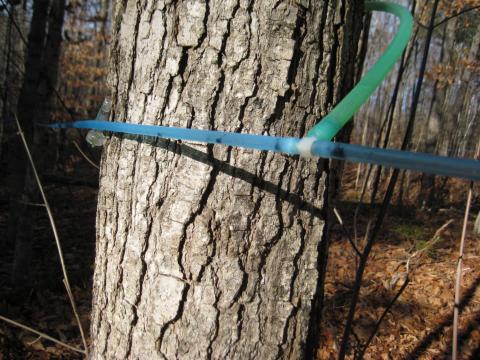Good Forestry in the Granite State—Maple Sugaring

March is New Hampshire Maple Month and the month that “cabin fever” either digs in, or starts to break. The same weather that brings humans relief accounts for the movement of maple sap—freezing nights alternating with warm, sunny days.
Making maple syrup is an important part of many families’ lifestyle and income. Tapping a few trees can be a fun and sweet family activity, though March is late to tap your trees. Serious sugar-makers tapped their trees in January or February.
The Key to Making Maple Syrup
Making maple syrup doesn’t start with tapping trees and boiling sap. It starts with healthy and plentiful maples, nurtured to develop large, spreading crowns. This takes time—at least 60 years for most woods-run maples. By woods-run, I mean maples that seeded themselves and weren’t thinned and nurtured in the early years. In other words, most of the maples growing in New Hampshire.
Steve Roberge, Cheshire County Forester and Extension’s maple specialist gives Maple Sugaring Tips for Beginners and Backyard Maple Sugar Producers. He covers tree choice (Sugar maple are the best to tap for sugaring, but reds can be as well.), tapping instructions, sap collecting, sizing the evaporator or pan, boiling sap, finishing syrup, filtering, packing, cleaning and grading and ends with a checklist of equipment and supplies.
Good Forestry’s chapter on maple sugaring focuses on managing forest-grown maples to help them develop the wide, spreading crowns that will produce sweet and plentiful sap. The chapter recommends how to tap trees so they stay healthy. Landowners who own a stand of maple trees will find helpful information in this chapter.
A stand is a grouping of similar trees and can be quite small. Many years ago, I lived at a Girl Scout camp and one of my duties was to teach scouts about mapling. My stand of maples was less than an acre, and I usually placed 25 taps in the trees (I counted 50 potential taps, but I never quite placed that many taps). Hundreds of girls learned about tree health, forest management and proper tapping techniques and I made many gallons of syrup over the years from that small stand of maples. Sweet!
Good Forestry in the Granite State: Recommended Voluntary Forest Management Practices for New Hampshire provides background information and suggestions on topics ranging from sensitive areas to selling timber and everything in-between. It is available for free at www.goodforestry.org or for purchase by contacting forest.info@unh.edu.
Related Resource(s)

